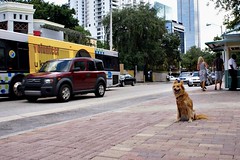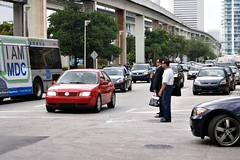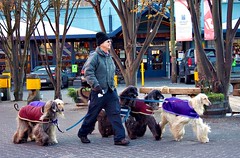A dog's-eye view of what makes a walkable neighborhood

Posted April 19, 2011 at 1:24PM
Today’s post is guest-written by Andrew Zitofsky, an urban planner with the town planning firm Dover, Kohl & Partners.
Walking the dog is a multi-daily event for most dog owners; it often serves as the beginning and end to our day. For some, walking the dog is seen as a chore, for others it’s an opportunity to bond with “man’s best friend” and explore their neighborhood. A dog walk might include a stop at the local park to sniff and run with the other neighborhood dogs, or a quick errand at a dog-friendly local shop.
Shea (our sheltie mutt-i-gree) is an energetic dog that loves her exercise, and my wife and I enjoy taking her on long walks, jogs and skates throughout [the Miami neighborhood of] Brickell. We are fortunate to live in an area with a relatively tight street grid (blocks are about 300’ x 600’, not perfect, but better than is often the case), newly implemented bicycle lanes (which double as dog-skating lanes), a fine-grained mix of uses, and several public gathering spaces, including a neighborhood park (where dogs are sort of allowed). On our excursions we’ve noticed both the good and the bad aspects of our public realm.
A well-known new urbanist transportation planner/traffic engineer touts “small block size” as the #1 contributor to walkability. As a daily dog-walker I couldn’t agree with Rick Hall more; having the ability to change course frequently makes our walks more interesting for both man and dog.  Unfortunately, while we do our best to change our path, we can’t help but gravitate towards the streets where we feel most safe and comfortable.
Unfortunately, while we do our best to change our path, we can’t help but gravitate towards the streets where we feel most safe and comfortable.
Block length, sidewalk dimensions and details, and adjacent building frontages are several of the many components of the built environment that affect both pedestrian and canine comfort. These details tell visitors (whether on foot or in cars) what kind of place they are in and how they should behave. This principle works on the neighborhood level, but also affects behavioral patterns on specific blocks and streets.
Many streets clearly show the priority placed on fostering pedestrian activity. South Miami Avenue (shown above) between SW 8th Street and SW 11th Street consists of a narrow 2-lane section with on-street parking. The adjacent development (Mary Brickell Village) with its ample sidewalks, sidewalk dining, and large numbers of pedestrians has a profound impact on the way that vehicles traverse the area. It tells drivers to travel slowly because this is a place for both cars and people; this part of my neighborhood is one where I feel most comfortable walking Shea and crossing streets without fear for our lives.
SW 1st Avenue is a prime example of a street that suffers from an extreme identity crisis. The Avenue consists of a pair of one-way thoroughfares which straddle the Miami Metrorail line. It is home to the Brickell Metrorail and Metro Mover Station, which also serves as a bus hub. On the west side, SW 1st is a residential road; while the lane markings are somewhat ambiguous, driver behavior is fairly civil. We can comfortably walk on the sidewalk and cross the street without much thought about speeding cars.
On the east side (photo just below) is where things get a bit hairy. The one-way road is made up of three poorly delineated, oversized travel lanes which encourage vehicle speeds that are ill-suited for this transit-serving environment. Despite high pedestrian traffic volumes and a clearly marked pedestrian crosswalk connecting the transit stop to the adjacent mixed-use development,  drivers respond to the physical configuration of the street and drive too fast through what should be a highly walkable area. (According to Hall, vehicle speed is directly related to the casualty rate associated with vehicle/pedestrian accidents). Crossing the street (even at the crosswalk) is a nightmare; I frequently have to communicate with traffic to get across and to help others who are stranded on one side or another. While I internalize the emotions that the road evokes, Shea wears her emotions on her tail. She sticks closely by, often with her tail tucked, as we navigate across, and returns to her typical proud prance once we make it to the other side. To my knowledge, Shea has received no formal education on road design or urban design, but somehow she just gets it.
drivers respond to the physical configuration of the street and drive too fast through what should be a highly walkable area. (According to Hall, vehicle speed is directly related to the casualty rate associated with vehicle/pedestrian accidents). Crossing the street (even at the crosswalk) is a nightmare; I frequently have to communicate with traffic to get across and to help others who are stranded on one side or another. While I internalize the emotions that the road evokes, Shea wears her emotions on her tail. She sticks closely by, often with her tail tucked, as we navigate across, and returns to her typical proud prance once we make it to the other side. To my knowledge, Shea has received no formal education on road design or urban design, but somehow she just gets it.
Some suggestions for “dog-walkable” urbanism:
- Wide Sidewalks: Ample sidewalks allow people to pass one another with some breathing room. They also provide an opportunity for people to stop and chat without preventing access to others.
- On-street Parking: Like their owners, dogs also want to feel comfortable walking down the sidewalk. Parked cars produce a transition between the sidewalk and the moving vehicles in the roadway and create a sense of safety and enclosure for pedestrians (and quadrupeds).
 Public Spaces: Parks, plazas, and squares, can provide a variety of recreational opportunities, both passive and active, and can serve as gathering places for the community. More, smaller parks and spaces will provide more residents (and their pets) access than fewer, larger ones.
Public Spaces: Parks, plazas, and squares, can provide a variety of recreational opportunities, both passive and active, and can serve as gathering places for the community. More, smaller parks and spaces will provide more residents (and their pets) access than fewer, larger ones.
- Eyes on the Street: Creating a safe (both statistically and by perception) public realm can be achieved through the careful planning of adjacent building frontages. Streets and space with blank walls or parking lots are often uncomfortable to walk along due to a feeling of vulnerability. On the other hand, shopfronts, doors, and windows all help make streets safer by providing built-in surveillance. In addition, dog owners are much more likely to take part in clean-up duty if they might be seen.
Planners, engineers and architects work hard (and with good intentions) to design our communities; let’s hope that they can continue to focus on creating environments where wheels, feet and paws can all be comfortable.
Andrew’s post first appeared on Dover, Kohl’s blog, which I recommend. The firm has graciously allowed it to be reprinted here.
Move your cursor over the images for credit information.
